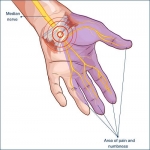
Numb fingers while driving? Tingling in the hands and fingers waking you up during the night? Aching and pain in the hand? All can be symptoms of carpal tunnel syndrome (CTS).
What is Carpal Tunnel Syndrome?
Carpal tunnel syndrome is a condition diagnosed when pressure is placed on the median nerve at the wrist. The median nerve is located at the wrist on the palm side of the hand and runs through a tunnel. This tunnel has the median nerve and 9 other tendons that attach forearm muscles into the hand to assist in motion. When swelling occurs, there is pressure build up onto that nerve and therefore you get symptoms of carpal tunnel syndrome such as tingling, numbness and pain at the arm, hand and fingers.
What is the Cause of Carpal Tunnel?
Pressure on the median nerve can happen for several reasons so the true cause of carpal tunnel syndrome is unknown. Swelling and pressure can be caused by but not limited to:
- Tenosynovitis (swelling of the lining of the flexor tendons)
- Joint dislocations/injuries to the joint
- Fractures
- Arthritis
- Pregnancy fluid retention
- Other medical conditions such as thyroid conditions, rheumatoid arthritis, and diabetes
Symptoms of Carpal Tunnel Syndrome

transverse carpal ligament compressed median nerve hand
Patients with carpal tunnel syndrome may complain of numbness, tingling and pain or all three. Usually these symptoms are felt in the thumb, index, middle and ring fingers. Patients complain of pain at night but may notice problems while holding a book, driving or reading a newspaper. Complaints of weakness in gripping objects and dropping things are also common noted problems. In most severe cases, sensation may be permanently lost and the muscles at the base of the thumb can shrink (atrophy).
Our very own, Kansas City Bone & Joint Clinic’s, Dr. Atul Patel is the only certified Electromyographer in the state of Kansas and he is going to go over some key points in what to expect when you have an EMG.
References: American Society for Surgery of the Hand

